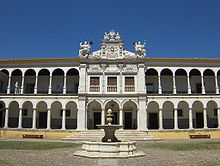University of Évora
Universidade de Évora | |
Latin: Universitas Eborensis | |
Former names | Universidade do Espírito Santo Instituto Universitário de Évora |
|---|---|
| Motto | Honesto estudo com longa experiência misturado |
Motto in English | Honest study mixed with long experience |
| Type | Public university |
| Established | 1559 1973a |
| Rector | Ana Costa Freitas |
| Students | 7,800[1] |
| Location | , 38°34′23″N 7°54′16″W / 38.5731°N 7.9044°W |
| Campus | Urban |
| Colours | burgundy and white |
| Affiliations | Compostela Group EUA UNIMED |
| Website | uevora.pt |
a Reestablished after its closure in 1779. | |
The University of Évora (Universidade de Évora) is a
It was reopened nearly two hundred years later in 1973 as Instituto Universitário de Évora (University Institute of Évora) by decree of the Minister of Education, José Veiga Simão, in the site of the older university,[4] as part of a set of education policies during the early 1970s that were attempting to reshape Portuguese higher education.[5] Six years later, in 1979, the name was changed to Universidade de Évora.[3]
History
The University of Évora, the second oldest in Portugal, was founded in the 16th century by the Archbishop of Évora
The Jesuit

The Colégio do Espírito Santo became famed as a centre of learning and rivalled the University of Coimbra. Among its eminent theologians and philosophers were Luis de Molina (1535-1600), Pedro de Fonseca (1528-1599), St. Francisco de Borja, St. João de Brito, Manuel Álvares. Several prelates of the Portuguese Empire were trained at this university: D. Afonso Mendes, Patriarch of Abyssinia, and D. Pedro Martins, first bishop of Japan. The classrooms are decorated with appropriate azulejos (ceramic tiles) such as "Plato teaching his followers" and "Aristotle teaching Alexander the Great".
The University of Évora resumed work in 1973 as a state-run university. The diplomas are granted in the 18th century Baroque chapel (Sala dos Actos) (restored in 1973), that dominates the Tuscan-arched Renaissance cloister.
See also
- List of early modern universities in Europe
- List of Jesuit sites
- List of universities in Portugal
- Higher education in Portugal
References
- ^ About (2024). The University of Évora. Retrieved online 10.02.2024 https://www.uevora.pt/en/university
- ^ "história". uevora.pt (in Portuguese). Retrieved 2015-03-08.
- ^ a b c d "a universidade". uevora.pt (in Portuguese). Retrieved 2015-03-08.
- ^ "Universidade de Évora – Colégio do Espírito Santo". visitevora.net (in Portuguese). 18 January 2014. Retrieved 2015-03-08.
- expresso.sapo.pt(in Portuguese). 3 May 2014. Retrieved 2015-03-08.
